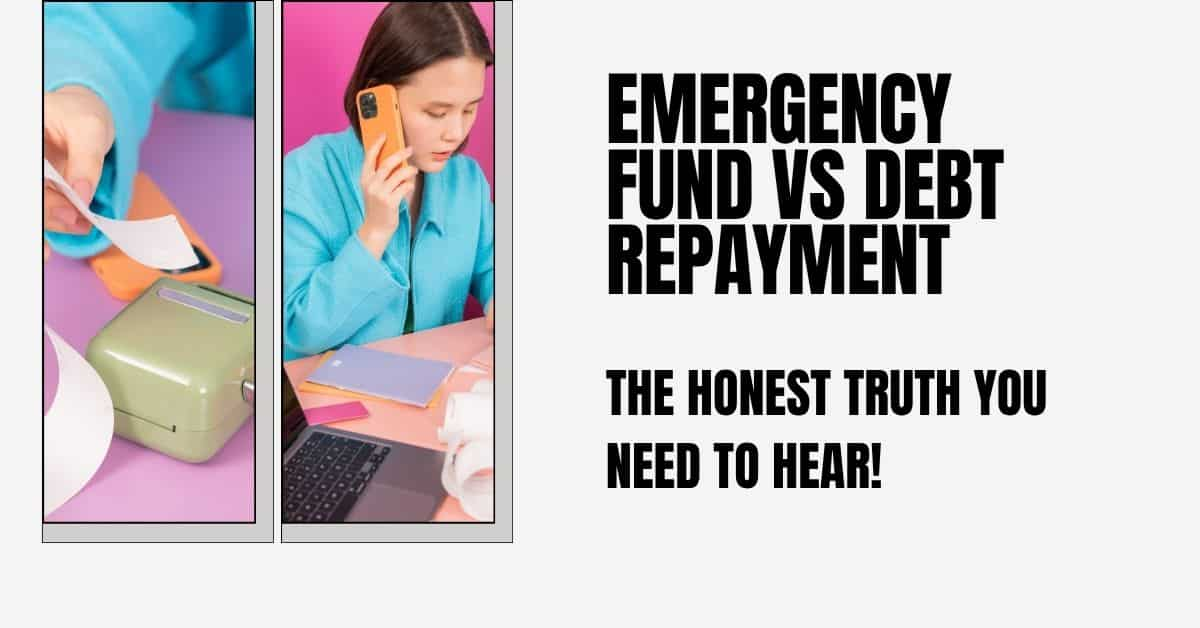Emergency Fund vs Debt Repayment Priority: Many households are struggling with growing living expenses and escalating debt as of September 30, 2025, with India’s inflation rate remaining at 2.07% for August following a drop of 1.61% in July. With per-person debt increasing 23% in just two years to almost ₹4.8 lakh, the average household debt in India has risen to about 42% of GDP. In the midst of this, a crucial financial challenge arises: Is it better to focus on aggressive debt repayment or emergency fund building? In an unpredictable economy where nearly half of Indians save less than 10% of their income, leaving many without sufficient emergency buffers, this decision is about protecting peace of mind more than just numbers.
Ignoring this goal might result in deeper debt cycles or make young professionals, families, or anybody else dealing with financial instability more susceptible to unforeseen costs like medical emergencies, which typically cost between ₹50,000 and ₹2 lakhs. A balanced approach is emphasised by financial experts: As recently advised by Discover and Bank rate, start with a small emergency fund of ₹10,000 to ₹50,000 before addressing high-interest debt. Written for Indian situations in 2025, this comprehensive guide reveals the real truth about emergency fund vs. debt repayment priority. We’ll go over the benefits and drawbacks of each, when to use each, a hybrid approach, detailed choices, actual cases, and a table of comparisons. Supported by up-to-date data and professional analysis, this article assists you in making wise decisions so you can accumulate money regrettably.
Although broad guidelines are applicable, individual circumstances such as job security and debt interest rates (credit cards have 36-42% annual percentage rates) are important. For specialised guidance, speak with a certified financial planner.
Recognising the Fundamental Conundrum: Debt Repayment vs. Emergency Fund
Fundamentally, this argument contrasts short-term security with long-term freedom. An emergency fund is a liquid cash reserve that is kept in high-yield savings accounts (up to 7.25% p.a. from banks like Ujjivan SFB) to handle unanticipated circumstances without taking out a loan. Typically, this reserve covers three to twelve months’ worth of critical costs. In contrast, debt repayment aims to lower interest costs and raise credit scores by paying off obligations such as credit cards and loans.
Setting priorities incorrectly can make problems worse in India in 2025, where family debt is 42% of GDP and savings rates are low (only 25% have enough emergency funds). For example, in the face of economic challenges, credit card defaults are increasing. Without funds, a job loss (affecting 10-15% in volatile sectors) necessitates high-interest borrowing, and neglecting debt allows interest to mount.
Important Statistics:
- 43% of wealthy people save less than 20% of their income, and many of them don’t have emergency savings.
- According to Bank rate, more Americans (relevant worldwide) will prioritise emergency savings and debt repayment in 2025.
Benefits and Drawbacks of Setting an Emergency Fund as Your Top Priority
Keeping a safety net in mind offers both practical and psychological protection.

Benefits
- Risk Mitigation: Provides emergency coverage without incurring additional debt; for example, a ₹1 lakh medical cost does not be added to an existing loan balance.
- Peace of Mind: Lessens stress because, according to CA insights, 80% of emergency funds fail because they are not set up correctly.
- Opportunity Cost: Beats inflation by earning interest (6-7.5% in liquid money).
- Flexibility: Perfect for families or jobs with unpredictable schedules.
Drawbacks
- The chance Loss on Debt: Fund returns are slower than the growth of high-interest debt, such as 18% personal loans.
- Delayed Freedom: Increases the total amount of interest paid by extending the debt’s term.
- Inflation Erosion: If static funds are not invested prudently, they lose value at an inflation rate of 2.07%.
Prioritise when there is no money or when debt interest is less than 6-7 percent (home loans, for example, are 8-9%).
Benefits and Drawbacks of Making Debt Repayment a Priority Initially
Cash flow is freed by an aggressive reward, but susceptibility is increased.
Advantages
- Interest Savings: Reducing 36% of credit card debt results in thousands of dollars in interest savings; for example, ₹1 lakh at 3% monthly equals ₹42,000 year.
- Improved Credit: Better credit raises scores for upcoming loans with reduced interest rates.
- Psychological Win: According to the snowball method, becoming debt-free inspires people.
- Long-Term Wealth: Provides post-payoff income for investments.
Drawbacks
- Lack of a Safety Net: 40% of low-income Indians borrow money for emergencies, which leads to cycles of debt.
- Opportunity Cost: Misses fund growth; for example, if a ₹50,000 fund is delayed at a rate of 7%, it loses ₹3,500 each year.
- Risk of Burnout: Budgets are strained by intense focus.
When to Choose: Stable income with employer assistance; high-interest debt (>10%) such as loans or credit cards.
Things to Think About in 2025: When to Prioritize
What determines your choice:
- Interest Rate on Debt: >7-8%? Pay off first (for example, credit cards against educational loans at 9–11%).
- Fund Size: According to experts like Jessica Moorhouse, start with a ₹1,000–10,000 mini-fund before moving on to debt.
- Job Stability: Gig workers must have 9 to 12 months’ worth of funds.
- Returns and inflation: Invest in high-yield securities to offset the expense of debt.
- Personal Situation: Singles may deal with debt; families prioritise money.
A hybrid approach involves building a fund of 10,000 to 50,000 and then repaying it using either avalanche (high-interest first) or snowball (little debts).
A Comprehensive Guide: Establishing Your Priorities and Acting Upon Them
- Audit Finances: Determine the entire amount of debt and interest rates, as well as the monthly expenses (the average household’s needs cost ₹15,000.
- Evaluate the risks: Debt with a high interest rate? Pay; no money? Build.
- Mini-Fund First: Make a 7% savings of ₹10,000.
- Repay Strategically: Repay strategically by using snowball for motivation and avalanche for math savings.
- Automate: additional payments for debt; SIP-like for funds.
- Review Quarterly: Review every three months: Make adjustments for changes or inflation.
- Seek Help: Use apps like Moneycontrol or the free RBI literacy materials to get assistance.
Pay down debt after ₹20,000 in funds to prevent cycles, for instance, if you have ₹50,000 in credit card debt at 36% vs no funds.
Examples from Real Life: Insights from Indian Families
- Case 1: A Mumbai professional with a 40% priority avalanche debt of 2 lakh paid down their card debt, saving 80,000 in interest before building a fund.
- Case 2: A gig worker in Bengaluru saved ₹1.2 lakhs for six months before losing their employment, allowing them to avoid taking on more debt.
- Hybrid Success: A couple balanced both by paying off a low-interest loan and saving money for emergencies, as advised by Truist.
Table of Comparisons: Debt Repayment vs Emergency Fund
| Aspect | Emergency Fund Priority | Debt Repayment Priority |
| Best For | Unstable jobs, no savings | High-interest debt (>10%) |
| Returns/Interest | Earns 6-7.5% | Saves 18-42% interest |
| Risk Level | Low (safety net) | High (no buffer) |
| Time Horizon | Short-term security | Low-term freedom |
| Tax Implications | Interest taxable >₹10,000 | Deductions on some debts (80C) |
| Psychological Impact | Reduces anxiety | Boosts motivation |
Common Mistakes to Avoid in This Discussion
- Ignoring Interest Thresholds: Fidelity advises paying off debt that is greater than 7% first.
- No Mini-Fund: Without the fundamentals, 80% of funds fail.
- Emotional Decisions: Take mentality and math into account.
- Ignoring Inflation: Modify fund goals by 5% per year.
Frequently Asked Questions (FAQs)
1. In 2025, should I prioritise debt repayment or emergency fund building?
Create a ₹10,000–50,000 mini-fund first, followed by high-interest debt (>7-8%).
2. What is the required emergency fund amount for Indians in 2025?
Expenses for three to twelve months; for example, ₹1-3 lakhs for typical homes.
3. In 2025, what is the average family debt in India?
Approximately 42% of GDP, or ₹4.8 lakh per person.
4. Why do emergency funds fail in 80% of cases?
Improper non-emergency setup or dipping.
5. Where should I put my emergency cash in 2025?
Liquid funds or high-yield savings at 6-7.5%.
Conclusion: The Equal Road to Monetary Well-Being
With debt at 42% of GDP and insufficient savings, the real picture of emergency fund vs. debt repayment priority in India in 2025 is a hybrid: Before managing high-interest debt, secure a little amount of money. This reduces expenses while providing emergency protection. You must begin auditing now if you want to maintain stability in the future.
Good Debt vs Bad Debt Explained: A Life-Changing Guide for Beginners
Debt Snowball vs Debt Avalanche: Best Way to Pay Off Loans in India
Infosys Buyback 2025: Could This be the Turning Point for Your Debt Worries?

I’m Rashid Ali, a personal finance blogger and content creator at SavingSecret.in, helping young adults in India master saving, investing, and tax planning. I simplify money topics like budgeting, IPO updates, and stock market tips to make finance easy and actionable. Follow me for smart money moves that actually work!
